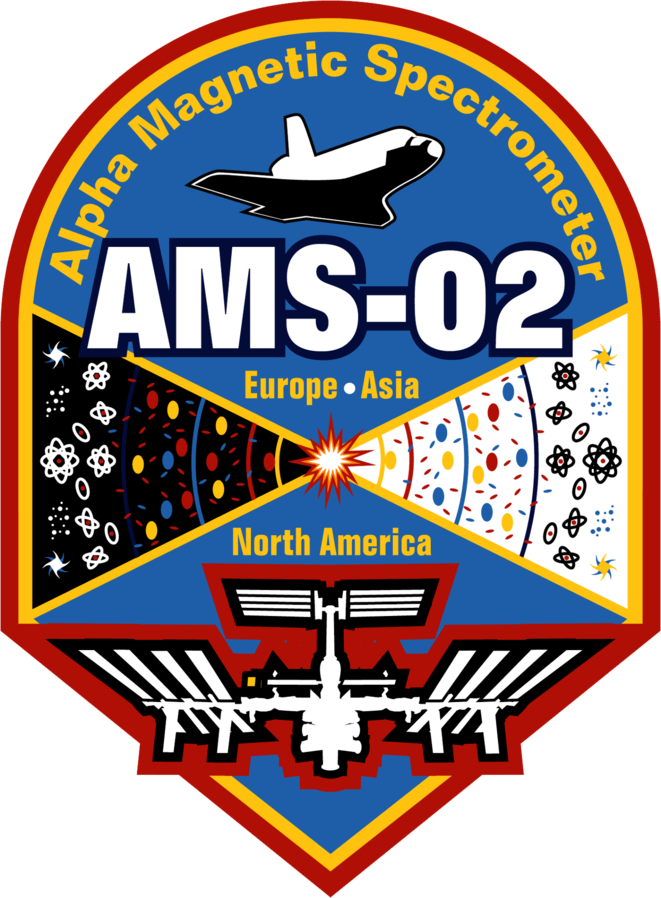Properties of Iron Primary Cosmic Rays: Results from the Alpha Magnetic Spectrometer
We report the observation of new properties of primary iron (Fe) cosmic rays in the rigidity range 2.65 GV to 3.0 TV with $0.62 \times 10^6$ iron nuclei collected by the Alpha Magnetic Spectrometer experiment on the International Space Station. Above 80.5 GV the rigidity dependence of the cosmic ray Fe flux is identical to the rigidity dependence of the primary cosmic ray He, C, and O fluxes, with the Fe/O flux ratio being constant at $0.155 \pm 0.006$. This shows that unexpectedly Fe and He, C, and O belong to the same class of primary cosmic rays which is different from the primary cosmic rays Ne, Mg, and Si class.
Table-SI
Download the tableThe Fe flux $\Phi$ as a function of rigidity at the top of AMS in units of $[{\rm m}^2 \cdot {\rm sr} \cdot {\rm s} \cdot {\rm GV}]^{-1}$ including errors due to statistics (stat.); contributions to the systematic error from the trigger and acceptance (acc.); the rigidity resolution function and unfolding (unf.); the absolute rigidity scale (scale); and the total systematic error (syst.). The contribution of individual sources to the systematic error are added in quadrature to arrive at the total systematic error.
Table-SII
Download the tableThe iron to oxygen flux ratio Fe/O as a function of rigidity including errors due to statistics (stat.); contributions to the systematic error from the trigger, acceptance, and background (acc.); the rigidity resolution function and unfolding (unf.); the absolute rigidity scale (scale); and the total systematic error (syst.). The statistical errors are the sum in quadrature of the ratios of iron and oxygen flux statistical errors to the corresponding flux values, multiplied by the Fe/O flux ratio. The systematic errors from the background subtraction, the trigger, and the event reconstruction and selection are likewise added in quadrature. The correlations in the systematic errors from the uncertainty in nuclear interaction cross sections, the unfolding and the absolute rigidity scale between the iron and oxygen fluxes have been taken into account in calculating the corresponding systematic errors of the Fe/O flux ratio. The contribution of individual sources to the systematic error are added in quadrature to arrive at the total systematic uncertainty.
Table-SIII
Download the tableThe iron to helium flux ratio Fe/He as a function of rigidity including errors due to statistics (stat.); contributions to the systematic error from the trigger, acceptance, and background (acc.); the rigidity resolution function and unfolding (unf.); the absolute rigidity scale (scale); and the total systematic error (syst.). The statistical errors are the sum in quadrature of the ratios of iron and helium flux statistical errors to the corresponding flux values, multiplied by the Fe/He flux ratio. The systematic errors from the background subtraction, the trigger, and the event reconstruction and selection are likewise added in quadrature. The correlations in the systematic errors from the uncertainty in nuclear interaction cross sections, the unfolding and the absolute rigidity scale between the iron and helium fluxes have been taken into account in calculating the corresponding systematic errors of the Fe/He flux ratio. The contribution of individual sources to the systematic error are added in quadrature to arrive at the total systematic uncertainty.
Table-SIV
Download the tableThe iron to silicon flux ratio Fe/Si as a function of rigidity including errors due to statistics (stat.); contributions to the systematic error from the trigger, acceptance, and background (acc.); the rigidity resolution function and unfolding (unf.); the absolute rigidity scale (scale); and the total systematic error (syst.). The statistical errors are the sum in quadrature of the ratios of iron and silicon flux statistical errors to the corresponding flux values, multiplied by the Fe/Si flux ratio. The systematic errors from the background subtraction, the trigger, and the event reconstruction and selection are likewise added in quadrature. The correlations in the systematic errors from the uncertainty in nuclear interaction cross sections, the unfolding and the absolute rigidity scale between the iron and silicon fluxes have been taken into account in calculating the corresponding systematic errors of the Fe/He flux ratio. The contribution of individual sources to the systematic error are added in quadrature to arrive at the total systematic uncertainty.
The CRDB at LPSC/IN2P3/CNRS, online since 2013, is fully described in Maurin et al. (2014, 2020)
The CRDB © SSDC is developed at the Space Science Data Center, a facility of the Italian Space Agency (ASI).
